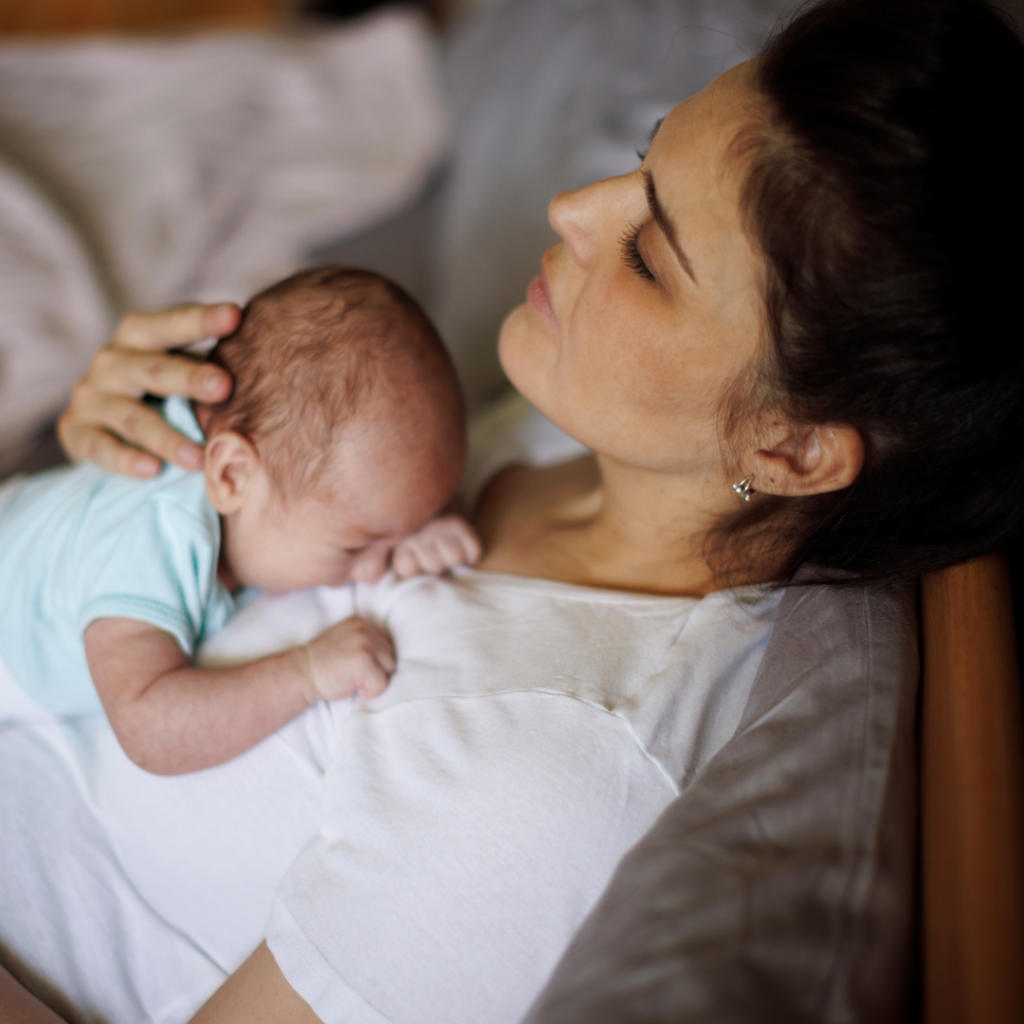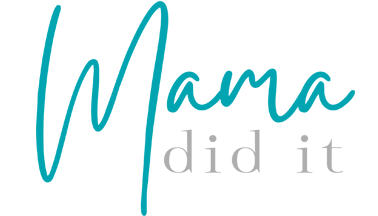Do you remember your first week postpartum? Tired as can be, breasts super tender, leaking from everywhere…and look how far you’ve already come. You are already at five weeks postpartum!
So much postpartum recovery has taken place. Though the fourth trimester continues for a few months, I don’t want you to lose sight of all you have already accomplished. Let’s dive into all the things for postpartum week five.
What should I feel at postpartum week five?
How are you feeling about your check-up next week? I always felt a bit nervous about it, but it really wasn’t a big deal. You can expect a pelvic exam, much like an annual pap smear. Your healthcare provider will take a good look at everything and then clear you for a pre-pregnant lifestyle. Be honest with them about how you are feeling.
Though your uterus is about back to its pre-pregnancy, normal size, your body isn’t. You can probably still see the linea nigra, the line down the middle of your stomach. Your belly button is probably still pretty stretched out, and you may notice some stretch marks. No worries though. All of these will continue to fade and shrink over the next few months.
Though weight loss has begun, it will come off slowly for the next several weeks. It isn’t reasonable to expect to be your pre-pregnancy size right now. There’s no rush here. We didn’t grow a baby overnight, and we won’t go back overnight.
Postpartum Week Five
Vaginal Bleeding:
By now, most new moms aren’t having lochia anymore and are free from maternity pads. That’s good news! If you are having some, the vaginal discharge will be light. More like spotting. At times, a mom who had a vaginal delivery will have postpartum bleeding for a few days after she has stopped bleeding. She may mistake this for a period, but if she’s breastfeeding, it’s probably not. Time will tell for sure.
Bleeding with breastfeeding if lochia has already stopped could be a scab opening up or could be a sign that you are being much more active than you were. The best thing is to try resting and see if it stops again.
Heavy bleeding at five weeks is usually the first menstrual period if a mom is bottle feeding or a fluke if the mom is breastfeeding. If you begin to soak sanitary pads in one hour, call your health care provider, but your risk of postpartum hemorrhage (signs are large blood clots that are golf ball size and excessive bleeding) is quite low now.
Perineal Care:
Taking care of yourself down there is pretty straightforward now. Any vaginal tear should be improving weekly. It’s normal to still feel sore depending on the degree of repair you had. Using occasional ice packs can offer relief. A warm bath can improve blood flow to the area which speeds healing.
Witch hazel pads are still great to use if you are dealing with hemorrhoids, stinging, or itchiness in your perineum or bottom. It’s okay to use toilet paper to wipe. Your risk of infection is quite low by now too!
Bowel Movement: Pooping and Peeing
You shouldn’t need a stool softener anymore to poop. If you are having trouble with constipation, check in on your food intake. Be sure you are staying hydrated and working in greens, vegetables, fruit, and whole grains.
Is it still burning when you pee? Most of the time by now, the burning has stopped. If you still feel burning at your urethra while urinating, you may have a slight tear there from a vaginal birth. This will continue to heal. Use a squirt bottle while peeing to relieve discomfort. If it hurts the whole time you pee, give your doctor a call.
Urinary incontinence (leaking pee) has probably improved on its own. Kegels may help with this too! (see below)
Exercise:
Just like with postpartum week four, it’s okay to introduce kind movements to your body. The goal is mindful movements like Kegel exercises, diaphragmatic breathing, or short flexibility routines. You can go for a walk now. In fact, research recommendations are to walk less than thirty minutes. You get an upgrade from the 15 minutes that was recommended in weeks past.
Remember, walking is safe if you can control your breathing while doing it and you aren’t increasing vaginal bleeding afterward. If your bleeding increases, it’s your body’s way of telling you to rest.
Pelvic Floor Exercises
Kegels are safe exercises to start if you would like to do them. These movements help tighten and strengthen the pelvic floor when done properly. There is also research suggesting that squats, lunges, and bridges are actually more effective at helping the pelvic floor recover than Kegels.
To do a proper Kegel, lie down flat on your back of side. Relax and try to be free of distraction. Inhale deeply. As you exhale, imagine lifting a blueberry with your vagina. Hold it. Then inhale again and imagine putting it back down. Make sure your booty stays unclenched. Your goal should be to do this 5-10 times a few days a week.
No matter what exercise you start with, start slow and be kind to your recovering body.
Sexual Intercourse
I personally recommend no sex until after your healthcare provider has seen you at your six-week follow-up visit. Not only are tears or episiotomies still healing, but your pelvic floor is too! Your uterus is still healing the wound left behind by your placenta, and your cervix may still be closing after the birth of a baby.
Some women feel eager to get back to sexual activity but most feel hesitation. Between low sex drives due to hormones plus decreased lubrication because of breastfeeding, you may not feel “in the mood” for some time. You probably will still feel soreness as well.
Go ahead and be thinking about birth control as your healthcare provider will talk to you about this next week. We will talk more details about the “first time” next week in postpartum week six.
Emotions:
Gone are the baby blues days. You may have had those the first three weeks after birth. It’s marked by emotional upheavals. By now, you should see an improvement in your overall mental health.

Postpartum Depression
Having a new baby can be rough! Anyone that says otherwise isn’t telling you the truth. Because of the demands of a newborn plus the brain plasticity in a new mom, we are at risk for postpartum depression. Things like communication issues in our relationship that creep up or our circumstances can also play a part in this.
If you feel you are experiencing postpartum depression, please reach out for help. There are times the chemicals in our brain simply don’t go back to normal after birth. You didn’t do anything wrong. PP depression usually takes medication and therapy to overcome. If you have never dealt with depression before, chances are, this is temporary.
Signs of postpartum depression are excessive worrying, unable to sleep when your baby sleeps, feeling numb or unable to connect with your baby, changes in appetite, intense sadness, or wanting to hurt yourself or the baby. Don’t play around with this stuff. Reach out for help. The sooner you get help, the sooner you can enjoy this season of life. A support group may also help.
Postpartum Anxiety and OCD (obsessive-compulsive disorder)
This is so much more common than people realize. Postpartum Anxiety and OCD often presents as intrusive thoughts. They can be quite alarming and cause a mom to feel that she’s “going crazy.” You aren’t.
This is caused by several things: estrogen and serotonin changes, brain plasticity, family of origin complications, and life circumstances. It’s important to separate yourself from any thoughts you are having. Instead of defending yourself with “I would never do that!,” say, “This is an OCD thought.”
If at any time these thoughts or feelings of shakiness, shallow breaths, or nail picking feel too much to handle, reach out to your doctor. If it’s causing you not to be able to sleep at night, it’s time to call.
Depression and anxiety medication are there to help you. There is no judgement in needing them and most of the time, you only need them temporarily. But they 100% can help you feel like yourself again so you can better enjoy your new baby.
Postpartum Psychosis
This is the scary stuff that causes mothers to wind up on the news. Postpartum psychosis can almost ALWAYS be prevented if a mother gets help for the things she needs. Oftentimes psychosis starts out as postpartum depression or postpartum anxiety. When untreated or ignored it can cause trouble down the road.
Swallow your pride by swallowing a pill if you need too. If at any time you feel unable to cope with depression or anxiety, it’s a sign you need some help healing.
It also may be a sign you need to let go of other’s expectations (or maybe your own expectations). It’s okay to say, “This doesn’t work for me.” Maybe exclusive breastfeeding is compromising too much of your mental health. Maybe rest at night is the most important thing you can do for yourself right now. Whatever it is, I encourage you to adjust. Taking care of you equals taking care of your baby.
Breastfeeding:
Some moms feel like their milk supply has decreased at five weeks postpartum. This could be true, but probably isn’t. Our bodies learn to be more efficient when breastfeeding. Ask yourself these questions:
- Do my breasts feel full when starting to feed and soft afterwards?
- Is my baby feeding 8-12 times in 24 hours?
- Is my baby having regular pee and poop diapers?
- Am I drinking plenty of water?
If the answer is yes to these questions, you probably have a good supply. If you are unsure, it’s a good idea to see a lacation consultant for a pre and post weight check to be certain.
You may experience some breast engorgement (feeling overly full) at times, especially if your baby skips a feeding in the night. Using cold compresses after nursing can help!
You may also experience a clogged milk duct. This feels like an overly full portion in your breast. Using a heating pad while nursing may help. Here are my tips for releasing a clogged duct.
Cesarean Birth:
Your incision site is looking better this week! I hope you aren’t feeling pain in it anymore. A cesarean section is major surgery, and it takes time to feel normal again.
You may need a postpartum wrap off and on. It can help you feel more stable. It can also help with low back discomfort. Now is a great time to use scar-reducing products like silicone strips. These are recommended after your incision has healed up, meaning no drainage or scabbing.
You probably feel pretty normal now after your cesarean delivery! You can now drive, bathe, and go for walks. How are your emotions?
Many c-section moms deal with grief that doesn’t creep up until weeks or months later after baby comes. Because many c-sections are unexpected, women deal with the loss of the birth they had hoped for. It’s important to let grief come when it comes. Please know you are no less of a mother for having a c-section.
Pain:
You probably aren’t feeling uterine contractions anymore. Your uterus is back to its normal pre-pregnancy size now. Woohoo!
Pain medication like Motrin or Tylenol is okay to take occasionally if needed. A heating pad can be your best friend, along with topical medicines like witch hazel pads and lidocaine cream.
Postpartum Week Five
Learning to be new parents is quite the adventure. Sometimes a perilous adventure, but an adventure none the less. I guarantee you are doing better than you may think. The best thing you can do is give yourself lots of grace on this journey and reach out for help when you feel you need it. You are strong, and you will make it.

